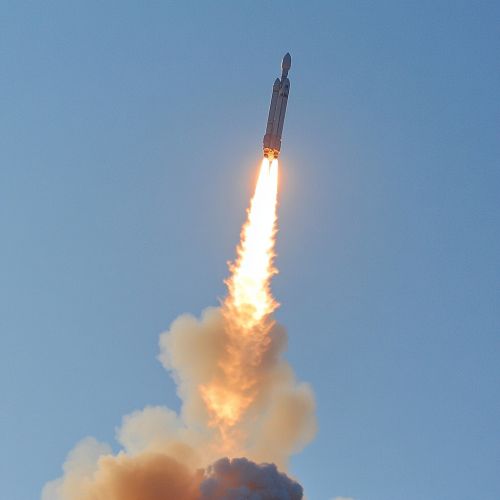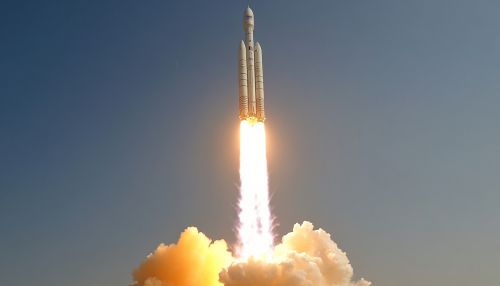Augmented Satellite Launch Vehicle: Difference between revisions
(Created page with "== Introduction == The **Augmented Satellite Launch Vehicle** (ASLV) was an ambitious project developed by the Indian Space Research Organisation (ISRO) to enhance India's capabilities in launching satellites into low Earth orbit. Conceived in the early 1980s, the ASLV was designed to bridge the gap between the Satellite Launch Vehicle (SLV) and the more advanced Polar Satellite Launch Vehicle (PSLV). It aimed to provide a cost-eff...") |
No edit summary |
||
| Line 59: | Line 59: | ||
* [[Indian Space Research Organisation|ISRO]] | * [[Indian Space Research Organisation|ISRO]] | ||
[[Image:Detail-98583.jpg|thumb|center|Launch of the Augmented Satellite Launch Vehicle from Sriharikota, India. The image captures the rocket ascending against a clear blue sky, with a trail of smoke and flames visible at the base.|class=only_on_mobile]] | |||
[[Image:Detail-98584.jpg|thumb|center|Launch of the Augmented Satellite Launch Vehicle from Sriharikota, India. The image captures the rocket ascending against a clear blue sky, with a trail of smoke and flames visible at the base.|class=only_on_desktop]] | |||
[[Category:Indian Space Program]] | [[Category:Indian Space Program]] | ||
[[Category:Launch Vehicles]] | [[Category:Launch Vehicles]] | ||
[[Category:Space Exploration]] | [[Category:Space Exploration]] | ||
Latest revision as of 08:39, 19 October 2024
Introduction
The **Augmented Satellite Launch Vehicle** (ASLV) was an ambitious project developed by the Indian Space Research Organisation (ISRO) to enhance India's capabilities in launching satellites into low Earth orbit. Conceived in the early 1980s, the ASLV was designed to bridge the gap between the Satellite Launch Vehicle (SLV) and the more advanced Polar Satellite Launch Vehicle (PSLV). It aimed to provide a cost-effective and reliable means of launching payloads of up to 150 kg into sun-synchronous orbits. Despite its limited success, the ASLV played a crucial role in the evolution of India's space program, providing valuable insights and technological advancements that paved the way for future launch vehicles.
Development and Design
The development of the ASLV began in 1982, with the primary objective of enhancing payload capacity and improving the reliability of India's launch vehicles. The ASLV was a five-stage vehicle, incorporating both solid and liquid propulsion systems. It was an augmentation of the SLV-3, with the addition of two strap-on boosters to increase thrust and payload capacity.
The first stage consisted of two strap-on boosters, each powered by a solid propellant motor. These boosters were derived from the SLV-3's first stage and were designed to provide additional thrust during the initial phase of the launch. The second stage was also a solid propellant motor, similar to the one used in the SLV-3. The third stage was a newly developed liquid propulsion system, utilizing a hypergolic combination of unsymmetrical dimethylhydrazine (UDMH) and nitrogen tetroxide (N2O4). This stage was responsible for providing the necessary velocity increment to place the payload into orbit. The fourth and fifth stages were solid propellant motors, designed to fine-tune the orbit and ensure precise satellite deployment.
The ASLV's design incorporated several innovative features, such as a closed-loop guidance system and a more advanced telemetry system. These enhancements were aimed at improving the accuracy and reliability of the launch vehicle, addressing some of the limitations observed in the SLV-3.
Launch History
The ASLV program consisted of four developmental flights, conducted between 1987 and 1994. Each flight was designated with the prefix "ASLV-D" followed by a number indicating the sequence of the launch.
ASLV-D1
The first flight, ASLV-D1, was launched on March 24, 1987, from the Sriharikota Range (SHAR). The mission aimed to place the SROSS-1 (Stretched Rohini Satellite Series) into a low Earth orbit. However, the launch was unsuccessful due to a failure in the vehicle's control system, resulting in the loss of the payload.
ASLV-D2
The second flight, ASLV-D2, took place on July 13, 1988. This mission also aimed to deploy a SROSS satellite, SROSS-2, into orbit. Unfortunately, the launch vehicle failed to achieve the desired orbit due to a malfunction in the strap-on boosters, leading to another mission failure.
ASLV-D3
The third flight, ASLV-D3, was conducted on May 20, 1992. This mission marked the first successful launch of the ASLV, with the SROSS-C satellite being placed into a near-circular orbit. The success of ASLV-D3 demonstrated the potential of the vehicle and provided valuable data for further improvements.
ASLV-D4
The final flight, ASLV-D4, occurred on May 4, 1994. This mission successfully deployed the SROSS-C2 satellite into orbit, further validating the design and capabilities of the ASLV. Despite the success of the last two flights, the ASLV program was discontinued in favor of the more advanced PSLV, which offered greater payload capacity and reliability.
Technological Contributions
The ASLV program contributed significantly to the technological advancements of India's space program. Some of the key contributions include:
Propulsion Systems
The development of the ASLV's liquid propulsion system marked a significant milestone for ISRO. The successful integration and operation of the UDMH and N2O4-based third stage provided valuable experience in handling hypergolic propellants, which would later be utilized in more advanced launch vehicles.
Guidance and Control
The closed-loop guidance system implemented in the ASLV was a major improvement over the open-loop systems used in earlier launch vehicles. This advancement enabled more accurate trajectory control and orbit insertion, laying the groundwork for future developments in guidance technology.
Structural Design
The ASLV's structural design incorporated lightweight materials and advanced fabrication techniques, resulting in a more efficient and robust vehicle. These innovations were instrumental in the development of subsequent launch vehicles, such as the PSLV and the GSLV.
Legacy and Impact
Although the ASLV program faced several challenges and had a limited number of successful launches, its impact on India's space program was profound. The lessons learned from the ASLV's development and operations informed the design and development of more advanced launch vehicles, ultimately contributing to India's emergence as a significant player in the global space industry.
The ASLV's legacy is evident in the success of the PSLV and GSLV programs, which have enabled India to launch a wide range of satellites for both domestic and international clients. The technological advancements and expertise gained from the ASLV program continue to influence ISRO's current and future projects, including the Chandrayaan and Mangalyaan missions.
See Also


